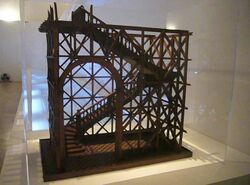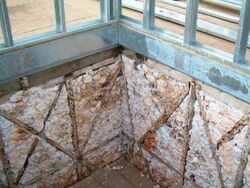Gaiola (construction)
Topic: Earth
 From HandWiki - Reading time: 3 min
From HandWiki - Reading time: 3 min
A gaiola pombalina (Pombaline cage; Portuguese pronunciation: [ɡɐjˈjɔlɐ]) is a masonry building reinforced with an internal wooden cage, developed as an anti-seismic construction system in Portugal after the 1755 Lisbon earthquake and implemented during the reconstruction of Lisbon Baixa (Lisbon downtown).[1]
Background
The catastrophic event of 1755 showed the fragility of the masonry construction, which is not able to absorb and dissipate the energy released by the earthquake. Downtown Lisbon was heavily damaged and, in anticipation of similar catastrophe, a new construction method was developed. The entire downtown was razed to make way for a rebuilding initiative, which was centered on the gaiola pombalina system.[2] The term gaiola meant "cage" and was named after the Sebastião José de Carvalho e Melo, the first Marquis of Pombal.[2][3] He was the Portuguese minister who introduced the building method.[2]
Features of the old buildings that survived were retained while those that did not were replaced.[4] There are sources that cite the construction methods in shipbuilding as the inspiration of the three-dimensional wooden structure.[5] Wood, being deformable, resists the forces of tension and compression that occur during an earthquake.
Features
Masonry is more effective than wood in resisting fires. Therefore, incorporating a wooden structure in masonry walls combined the advantages of both types of construction. The gaiola pombalina building features a traditional timber flooring and a hybrid timber-masonry shear walls.[6] The walls were constructed using a wooden truss system that was filled with masonry in the empty areas.[6]
The gaiola pombalina system was also adopted by other European cities. There is the case of the palace built according to the concept of gaiola in the town of Filogaso in the Calabria region. It was the only remaining building after the town was completely destroyed by an earthquake in 1783.[7]
See also
- Pombaline style
References
- ↑ Linköpings universitetsbibliotek[yes|permanent dead link|dead link}}]
- ↑ 2.0 2.1 2.2 Bratley, Carrie-Marie (2020-05-26) (in en). Moon Lisbon & Beyond: Day Trips, Local Spots, Strategies to Avoid Crowds. Avalon Publishing. ISBN 978-1-64049-338-4. https://books.google.com/books?id=RrhPDwAAQBAJ&dq=gaiola+pombalina+masonry+fire&pg=PT54.
- ↑ Dan, Maria Bostenaru; Armas, Iuliana; Goretti, Agostino (2014) (in en). Earthquake Hazard Impact and Urban Planning. Dordrecht: Springer Science & Business Media. pp. 220. ISBN 978-94-007-7980-8.
- ↑ Mortal, António; Aníbal, Jaime; Monteiro, Jânio; Sequeira, Cláudia; Semião, Jorge; Silva, Manuela Moreira da; Oliveira, Miguel (2018). INCREaSE: Proceedings of the 1st International Congress on Engineering and Sustainability in the XXI Century - INCREaSE 2017. Cham, Switzerland: Springer. pp. 534. ISBN 978-3-319-70271-1.
- ↑ Correia, Mariana R.; Lourenco, Paulo B.; Varum, Humberto (2015) (in en). Seismic Retrofitting: Learning from Vernacular Architecture. Leiden: CRC Press/Balkema. pp. 18. ISBN 978-1-138-02892-0.
- ↑ 6.0 6.1 Cruz, Helena; Machado, José Saporiti; Costa, Alfredo Campos; Candeias, Paulo Xavier; Ruggieri, Nicola; Catarino, José Manuel (2016) (in en). Historical Earthquake-Resistant Timber Framing in the Mediterranean Area: HEaRT 2015. Cham: Springer. pp. 175. ISBN 978-3-319-39491-6.
- ↑ Cepin, Marko; Bris, Radim (2017) (in en). Safety and Reliability. Theory and Applications. Boca Raton, FL: CRC Press. ISBN 978-1-351-80972-6.
 |
 KSF
KSF

